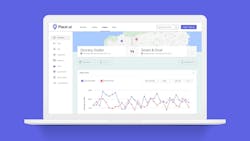How can builders and developers use technology to drive the ball forward and gain greater efficiencies? Several tech companies and connoisseurs came together to discuss just that at the Housing Innovation Alliance’s latest 3rd Tuesday event, Driving Efficiency + Attainability through Tech + Data.
One tech-driven solution comes from a company that specializes in human mobility, and how to use data to make the best building decisions.
PLACER.AI AND “UNPRECEDENTED VISIBILITY”
Placer.ai is a location intelligence data platform that uses foot traffic and heat maps to see where people go. They’re interested in researching the patterns of mobility that people go through, and specifically where they like to spend their time. But don’t worry, they’re not tracking your every move.
“We’re not after understanding where John Smith lives. We’re interested in relating patterns of human mobility to places,” says Stefan Martinovic, vice president of Data Partnerships at Placer.ai.
So, think airports, retailers, commercial real estate, and transportation services. This is a tool that hotel chains, for example, could use to gain insight on their place in the market, and where they might take their next venture.
There are also more practical uses for Placer, says Martinovic—like how he used the product to see wait times for his vaccination appointment. He also compares it to using Google services that tell you how busy a restaurant is at a certain time, or how long a food delivery might take.
“It’s the same underlying approach, except we’re not Google—we take a very privacy-forward approach to this,” says Martinovic.
So, how can this be used to help homebuilders?
DATA-DRIVEN DEVELOPMENT IN HOMEBUILDING
Martinovic suggests that homebuilders and developers could use Placer.ai to validate demand in their area. He gives an example of someone looking to build a second home community: use Placer to research counties in a specific region, see which places have more traffic, and go from there.
According to him, one could even dissect the data by date-range. If that proposed county had an uptick of people visiting on the weekends, that might tell a potential developer that there’s a demand for second homes in the area. As a real estate developer himself, the VP has even used Placer to gain insight on occupancy levels, most-used amenities, and duration-of-stay at competitive properties.
Martinovic says that this type of analysis that used to take him months to do with other mobility data services, can be done by Placer in a matter of minutes.
“It’s really like taking this big, hairy mess of data and turning it into charts, maps, and tables that real estate practitioners can get value out of,” he says. “It gives me knowledge of my property and how I can get the most bang for my buck.”
While Placer started out its journey through mobile phone-driven location data, it’s moving into the use of satellite imagery and sensors to enhance the platform.
For more information on Placer’s platform and privacy, visit their website or watch a snapshot from the event below. If you’re interested in learning more about the Housing Innovation Alliance, click here.
For more on industry-shaping technologies, read it here on Utopia.

